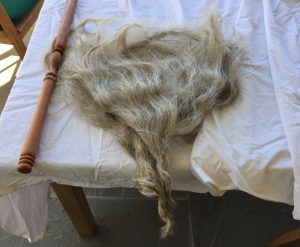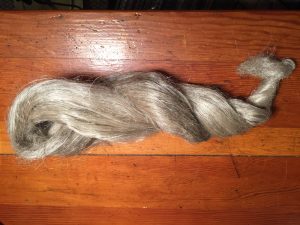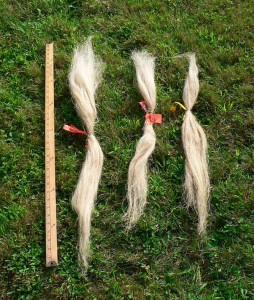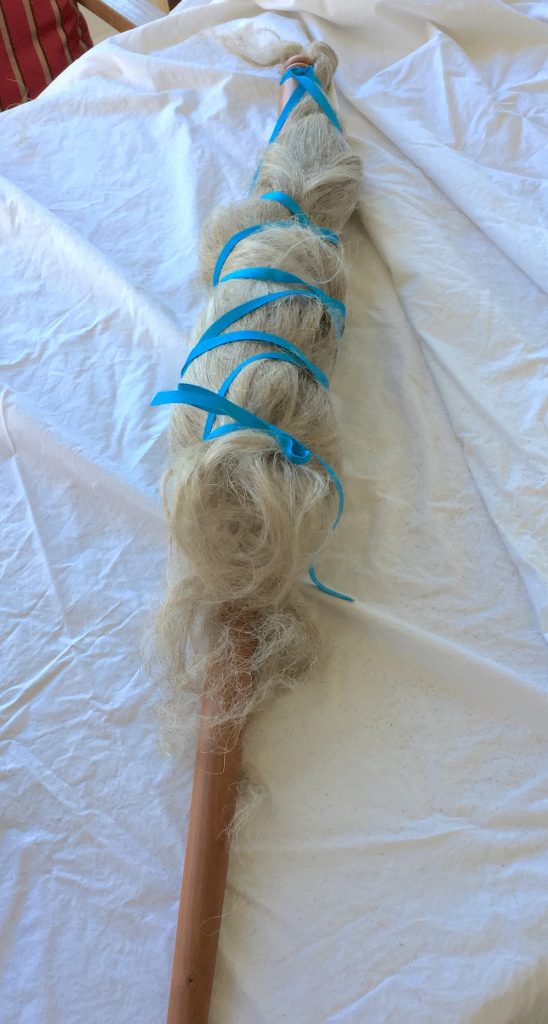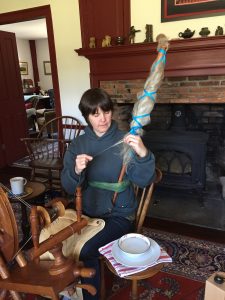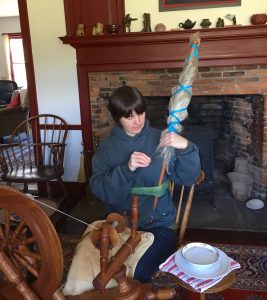Last week was April vacation, which meant I had more free time than usual to do fun things. Last Tuesday I was thrilled to spend about four hours with Lisa Bertoldi getting some instruction in spinning flax. You might think, with all the flaxy things I do, that I would already be good at spinning flax. Not yet. It has been a goal for me for many years, but recently it has made it to the top of my “urgent” list. Urgency plus vacation days equals actually devoting time to it! Thanks to Lisa, I am quite a bit better at spinning flax now. (12/30/2023 Edited: Lisa no longer has a website but you can read more about her on the Working Weavers Studio Trail website)
Here is the strick of flax spread out on the table. I am getting the fiber ready to dress the distaff. You can see the distaff on the left:
A strick is a neat arrangement of long flax fibers known as “line”. The preparation usually comes in a neat twist, which looks like this:
When you first buy them, they are usually very neat and tidy, This one has come with me on a few flax processing demonstrations and educational programs. As a result, it has been handled quite a bit, and is not as tightly twisted as it once was.
This is not my own home-grown flax. This is some lovely dew-retted flax, which is why it has that soft greyish-silver color. I always water-ret my flax, which results in a light creamy-beige color. Sometimes it comes out quite bright, almost white. Here’s a photo of some of my own flax from 2012 and 2013:
Eventually I will spin up my own home-grown and hand-processed flax and weave it into something wearable. Meanwhile, I am using commercially bought flax to practice the techniques and hone my skills.
Here is the distaff with the flax distributed around it and tied in place. It is not expertly done, but I still think it looks very pretty:
I have always felt it was kind of odd that when you are processing the fiber, you put so much work into straightening up all the long fibers and getting them all nicely aligned. However, when you get ready to spin, you wrap the fibers around a distaff in a criss-crossing, jumbled sort of way. Conversations with flax spinners over the past several months have convinced me that it is, in fact, sensible. The reason to spread all the fibers around a distaff is that when you draw them down, you can more easily control exactly which fibers come into the drafting zone, and which fibers catch the twist and get drawn in as you spin.
Here are two views of me spinning:
You can see that with this style of distaff, we supported it by pushing it down into a belt around our waists. In the photo on the left, I am trying to figure out how to allow fewer fibers into my yarn. In the photo on the right, I have figured it out (somewhat!), and am trying to practice a rolling motion with my lower hand that allows moisture to reach across all the fibers and keeps the fibers continually grabbing onto each other. I would describe the sensation as attracting nearby fibers with a sort of twisty electricity, by briefly separating the fibers to increase the surface area of each strand of fiber so they can all wrap around one another securely with maximum contact.
The water bowl in the foreground is for wetting our fingers periodically. I was wetting my lower hand to moisten the fibers, and keeping the upper hand dry. Wet spinning allows for a smoother yarn. The towel on my lap is to catch drips.
While I managed to produce a consistent yarn after a couple hours, I also got a stiff neck using this set up. Lisa suggested tipping the distaff forward so it would be in front of me, but this felt awkward and insecure at the time. However, I think that having the fibers in the same line of sight as the orifice of the wheel would be much more comfortable and ergonomic.

